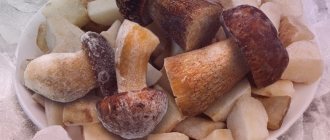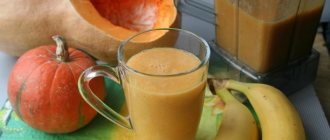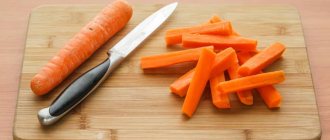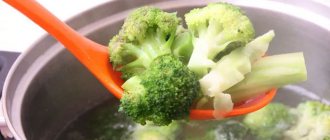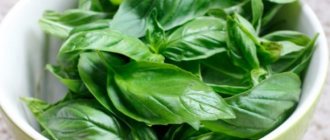During the summer season, the body can obtain sufficient amounts of vitamins and minerals from fresh vegetables and fruits. With the onset of cold weather, it is recommended to freeze a certain amount of fresh vegetables from the garden in order to be able to receive all the useful substances at any time. Below is detailed information on how to freeze tasty and healthy zucchini for the winter, what recipe options are available, and how to properly store the preparations.
The benefits of frozen zucchini
Zucchini is very useful for normalizing the water-salt balance in the body by removing excess fluid from it. Due to the content of a large number of essential elements and vitamins, it is used for many diseases.
Proper freezing of zucchini for the winter will ensure that the fruit retains its beneficial qualities until spring.
Nutritionists have conducted numerous studies, during which it turned out that they are one of the most inexpensive and reliable sources of substances important for the body during winter: vitamins A, B1, B2, C, PP, trace elements, minerals (including potassium, iron, magnesium , manganese, phosphorus, selenium, zinc, sodium).
Important information
Frozen zucchini can cause harm to the body only in one case - when defrosting and re-freezing. Once thawed, vegetables will spoil when exposed to air.
Reviews from housewives
Kiseleva Lyudmila, Kazan: “I’ve been freezing zucchini for several years now. It's so convenient, I don't understand why not everyone does it. I have my own rule: I wash the zucchini in three waters before freezing. The skin becomes soft and is completely invisible when cooking.”
Olga Evtunaeva, Nizhnekamsk: “I froze zucchini for the first time this summer. We live with a large family and need to cook several times a day. Plus we have a lot of kids. Frozen zucchini is an excellent complementary food for infants.”
Kristina Shemakhina, Yekaterinburg: “My grandmother taught me how to freeze zucchini. I never freeze them in plastic containers. There is no way to remove the air from them. But zucchini doesn’t like it. That's why I use double plastic bags. Most often I ice it in circles because I cook them with potatoes in the oven or simply fry them. You know, in winter you so often want a piece of summer.”
Elena Mironenko, Cheboksary: “I love zucchini in any form. We plant different varieties. My advice to summer residents: do not put off freezing until the end of the season, when you are already tired of the harvest. Do the opposite. The first fruits have arrived - we freeze them right away. The first vegetables are stored much longer, they contain many useful substances. And once you have prepared your supplies for the winter, eat fresh zucchini for your health.”
How to choose zucchini
Proper preparation for winter storage is very important.
Of course, the best option for freezing would be homemade fruits, but if they are not available, you need to select zucchini.
- They must be young - this can be seen by the thin peel, with small seeds inside.
- The color can be any: green, white, yellow. The main condition is that everything must be fresh, whole, clean, with shiny skin, without scratches, stains, or rotten places.
Only in this case will the prepared vegetables retain their vitamins and shape in the freezer throughout the winter.
Sluggish, long-harvested vegetables are not suitable, the same applies to unripe or overripe ones.
The next step for proper selection is to pierce the peel: if the zucchini is good, the peel is soft and easy to pierce. A hard and hard layer of skin indicates that the pulp is too fibrous.
Zucchini puree from boiled vegetables
To freeze zucchini puree, boil the zucchini for 10 minutes, cool and drain. Then puree in a blender or rub through a sieve. Pour the well-chilled mixture into molds and place in the freezer.
What dishes to use for
Such zucchini are used for feeding children of the first year of life, as well as for preparing soups with a puree consistency and vegetable sauces. To do this, the puree is defrosted completely, whipped again and heated.
General rules for freezing
Vegetables must be prepared for freezing
To properly freeze zucchini, you need to prepare them:
- wash thoroughly;
- spread on a clean napkin and dry with a paper towel (excessive moisture on the surface is not needed) or wipe each fruit well;
- cut off the tails.
Another option for blanching is to keep the vegetables in boiling water for a couple of minutes. You need to place a pot of boiling water and a container of cold water next to it. Cut the zucchini into not very large pieces, place in a colander in boiling water, after 2 minutes remove and immerse in a container to cool. Lay out the pieces to dry.
If anyone doubts the taste of the preparations obtained using this method, you can simply blanch the chopped zucchini for about 3 minutes, spread them out and cool them completely. After which they are ready to be packaged and placed in the freezer.
Useful tips
Young zucchini can be left in the skin over the winter. They usually do not have seeds, but if they are found, the pulp will need to be removed.
If you come across fruits with a thick and rough skin, they definitely need to be peeled and the pulp and seeds removed.
Preparation process
Algorithm for preparing zucchini for freezing:
- Thoroughly rinse the batch of vegetables intended for freezing.
- Wipe each fruit dry.
- Peel large fruits from peels, seeds and adjacent chaff.
- Grind.
- Blanch (optional).
- Cook in advance: fry until done in slices, saute, cook caviar - if desired.
- Squeeze out the mass if it was crushed using a grater or blanched.
- Dry slightly by spreading a mass of cubes, sticks, and circles in one thin layer on a table, baking sheet, or large flat plate.
- Collect in a bag (vacuum, regular), place on a cutting board, the size of which is smaller than the width and depth of the freezer.
- Place the packaged product in the chamber.
Harvesting methods
You can freeze homemade zucchini for the winter in different ways: fresh and fried. Let's look at the main ones.
In circles
This method is suitable for lovers of fried zucchini and casseroles.
Before final freezing, they must first be prepared: cover the board with plastic wrap, lay out rings 1-1.5 cm thick. Place in this form in the freezer until completely frozen.
This is done to maintain the shape of the circles so that they do not freeze to each other and break.
Take it out, pack it in bags or containers, and put it back until ready to cook.
Cubes
Freezing cubes is convenient to use
This preparation is convenient to use in winter for soup and stew.
Cut the zucchini into cubes (1-2 cm). Before distributing into bags, blot any juice that appears on the slices with a paper towel.
Package little by little (in such portions as to be enough for one time). You can put it in bags, tying them tightly, or in containers, closing them with lids. Place in the freezer.
There should be no air left in the bags. Flatten the bags into a flat layer - this will ensure quick coverage with cold.
In grated form
This method of freezing zucchini requires the use of a medium grater. Grate them, drain the excess liquid, distribute them into containers and place them in the chamber.
You can mix it with grated carrots - you get a ready-made mass for vegetable pancakes.
With rice
In combination with the fiber of zucchini, rice can provide the body with energy.
Procurement rules:
- Boil 1 cup of washed rice in salted water until half cooked.
- Heat the oil in a cauldron, fry 1 kg of onion in it, add rice, 1 kg of fresh zucchini cut into small pieces, add salt and spices at your discretion.
- Simmer for half an hour, covering with a lid.
- Place the completely cooled mixture in containers and place in the freezer.
Fried
You can also stock up on fried zucchini. You will end up with a ready-made dish that just needs to be heated in the microwave.
To do this, you need to cut vegetables into circles, add salt, roll in flour, and fry in vegetable oil. Place in a colander and allow excess liquid to drain from vegetables. Leave until completely cool.
Pack into prepared containers, close tightly, tie, and place in the freezer.
Puree
Zucchini puree is good for babies
For a child, it is best to freeze it in the form of zucchini puree: it is good for newborns and has a beneficial effect on the functioning of the gastrointestinal tract.
The prepared vegetables are cut into cubes, blanched in boiling water until almost completely cooked, and placed in a colander to drain the liquid. Grind to a puree consistency in a blender.
The puree is placed in portions into containers, tightly closed, and placed in the freezer. In this form, the puree can be stored for 8 to 10 months. It cannot be defrosted and re-frozen.
For infants, it is advisable to prepare the puree separately, making it from the youngest vegetables - it will be more tender.
Entirely
Young, tender, small-sized vegetables can be used whole. Of course, they take up a lot of space in the freezer. This needs to be taken into account.
In regions where temperatures are below 10°C most of the year, you can store frozen foods on an icebox, in the basement of a house, etc.
What is the best way to freeze?
To store vegetables in the freezer, you can use any container that can withstand prolonged exposure to low temperatures:
- special vacuum bags;
- silicone molds;
- food plastic containers for 250 ml or 500 ml.
Containers and bags must be clean and dry. You should try to squeeze out all the excess air from the bag.
Glassware and very thin bags should not be used as containers for freezing at home. Glass can crack, and the thinnest polyethylene becomes brittle after freezing and falls apart.
It is worth sticking a label on the container or bag indicating the name of the vegetable, method of preparation and date. After lying in the freezer for several months, preparations of vegetables of the same color become similar to each other, so without the inscription it is difficult to distinguish where the zucchini is fried and where it is blanched.
Advice from experienced pp specialists
If the zucchini will be used for frying, boiling or stewing separately, then it is not necessary to defrost it. If they are planned to be used in a soup, sauce or stew, then they should be defrosted before adding to the hot mixture. First, the bag or container is placed in the refrigerator for gentle defrosting, then the resulting liquid is drained and kept at room temperature until warmed. After this, put it in a dish. Adding ice-cold ingredients to your food will negatively affect the taste.
The shelf life of fresh frozen zucchini is 10 months, and that of zucchini after heat treatment is six months. By freezing them in June-July, you can enjoy zucchini dishes in mid-spring.
It’s very tasty to add cream and herbs to frozen zucchini dishes.
Irina Polyanitsa My name is Irina, I am the owner and admin of the site, as well as the author of most of the recipes and articles. I love to cook simple and healthy delicacies. Certified gym instructor, personal trainer. She completed a course on nutrition and health at Stanford University, Stanford Introduction to Food and Health, as well as a course at Ludwig Maximilian University of Munich (LMU) Nutrition and Lifestyle in Pregnancy (about nutrition and lifestyle during pregnancy).
